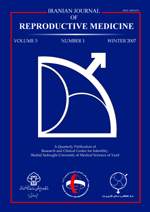
|
International Journal of Reproductive BioMedicine
Research and Clinical Center for Infertility, Shahid Sadoughi University of Medical Sciences of Yazd
ISSN: 1680-6433
EISSN: 1680-6433
Vol. 14, No. 12, 2016, pp. 783-786
|
 Bioline Code: rm16102
Bioline Code: rm16102
Full paper language: English
Document type: Case Report
Document available free of charge
|
|
|
International Journal of Reproductive BioMedicine, Vol. 14, No. 12, 2016, pp. 783-786
| en |
Neuroendocrine carcinoma of the ovotestis: A case report and review of literatures
Ashrafganjoei, Tahereh; Sourati, Ainaz & Mohamadianamiri, Mahdiss
Abstract
Background: Neuroendocine carcinoma of the gynecologic tract is rare and poses a significant clinical challenge because of tumor heterogeneity and lack of standardized guidelines for treatment. Ovotestis refers to the histology of a gonad that contains both ovarian follicles and testicular tubular elements. Ovotesticular disorder of sexual development occurs in fewer than 10% of all disorders of sexual development. Gonadal tumors with malignant potential occur in 2.6% of all cases of ovotesticular disorder of sexual development.
Case: Here we represent a 77-year-old woman with primary amenorrhea, infertility and 10cm solid mass in left adnex with 46 XY in karyotype with ovotestis neuroendocrine neoplasm in pathology report which was treated with a multi-modality manner including surgery and chemotherapy but she came back with pulmonary metastasis after 2 cycles of chemotherapy. For women who present with a stage 1 primary ovarian neuroendocrine tumor the prognosis is excellent with greater than 90% survival. Neuroendocrine tumor of the ovary represents 3 % of all neuroendocrine tumors. The prevalence of ovotestis is 1/20000 births. For women with more advanced disease, the prognosis is poor. Neuroendocrine carcinoma of the ovary is a rare and aggressive tumor commonly associated with other surface epithelial and germ cell neoplasms. The prevalence of ovotestis is 1/20000 births and gonadal malignancies are the most reported neoplasm affected the ovotestis. Here we report a case of ovotestis which is presented with neuroendocrine carcinoma and poor prognosis.
Conclusion: Neuroendocrine carcinoma of the ovary is a rare and aggressive tumor commonly associated with other surface epithelial and germ cell neoplasms. The prevalence of ovotestis is rare and gonadal malignancies are the most reported neoplasm affected the ovotestis.
Keywords
Neuroendocrine carcinoma; Ovary; Carcinoid tumors.
|
| |
© Copyright 2016 - Iranian Journal of Reproductive Medicine
Alternative site location: http://www.ijrm.ir
|
|
